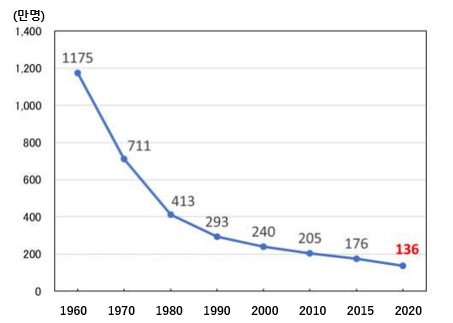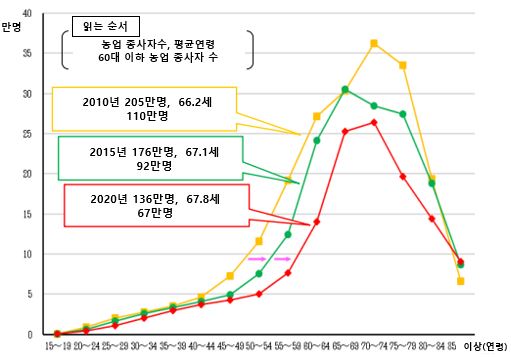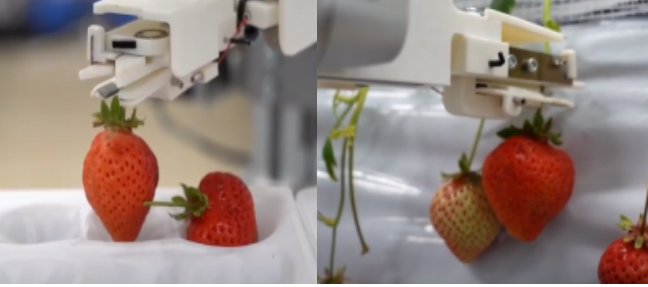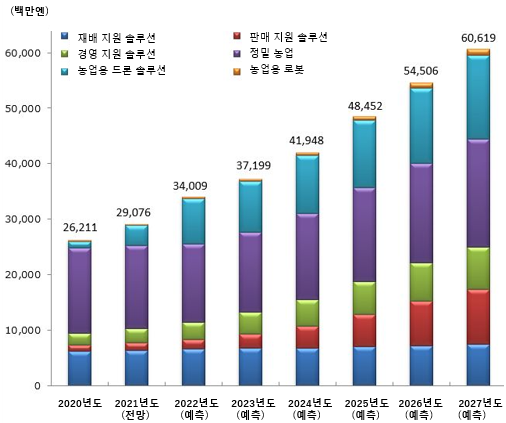Due to the aging population and the decrease in the number of agricultural workers, the problem of labor shortage in Japanese farm households is intensifying.
Efforts to solve problems with smart agriculture using IT and machinery
Currently, in Japan, labor shortage has become a serious problem due to the decrease and aging of the number of agricultural workers. According to data from the Ministry of Agriculture, Forestry and Fisheries, the number of agricultural workers in Japan has steadily declined since recording 1960 million in the 1175s, reaching 1980 million in 413 and 2020 million in 136. Smart agriculture is attracting attention to solve this labor shortage problem, and we looked at harvesting robots, which are part of it.
<Trends in the number of agricultural workers in Japan>
(Unit: XNUMX persons)
[Source: Ministry of Agriculture, Forestry and Fisheries]
Current status of the number of agricultural workers in Japan and difficulties due to labor shortage
<Age composition of agricultural workers in Japan>
(Unit: XNUMX persons)
[Source: Ministry of Agriculture, Forestry and Fisheries]
The average age of agricultural workers in Japan is increasing, which seems to be due to the decrease in the number of agricultural workers in their 60s or younger. In 2010, there were 60 million agricultural workers under the age of 110, but it continued to decrease, reaching 2020 in 67. The average age of agricultural workers increased from 2010 years in 66.2 to 2020 years in 67.8, indicating that the average age of agricultural workers increased by 10 years over 1.6 years.
In agriculture, there are many tasks that still depend on manpower, such as crop sorting that requires a lot of manpower, work that requires skilled skills such as tractor operation, and work that requires human hands due to difficulty in mechanization.
Efforts to Solve the Labor Shortage Problem of Japanese Farmers with Smart Agriculture: Harvesting Agricultural Robots
Japan is trying to solve these difficulties of Japanese farmers facing labor shortage through smart agriculture using IT and machinery.
1) Inak System: Robotsmi
Harvesting is an area that is still difficult to implement in smart agriculture using IT devices and machines, and Japanese small and medium-sized enterprises and emerging companies are working hard to develop robots in this field. Inak System (Inak System) is a company that the Japanese government is also paying attention to, and the robotsumi developed by this company is an automatic harvesting robot that harvests Japan's 'Amaou*' without damaging it.
Note*: It is a high quality strawberry variety from Fukuoka Prefecture, and the surface is easy to get soft.
Strawberries need to determine which ones to harvest and which ones to keep, and for this, Inac System filmed a video at a partnered strawberry farm. Based on this, after creating data that can determine whether strawberries should be harvested, the robot was taught how to classify strawberries and determine harvest.
<Robotsumi developed by AINAC System>
[Source: Inac System YouTube]
Later, when the robot was actually used, Amao farmers in Fukuoka Prefecture needed to lift strawberries from the floor in order to use the robotsumi. In the case of Amao, it is heavier than other varieties of strawberries, so it is grown by laying the strawberries on a soft cloth on the floor to prevent the stem from breaking. In order to cut strawberries lying horizontally without damaging them, they went through several trials and errors, and improved the function of the robot using a 3D printer, contributing to reducing production costs for farmers.
2) inaho
Another startup that is attracting attention from Nonghyup and local governments with these automatic harvesting robots is inaho. Inaho's automatic vegetable harvesting robot was exhibited at the "Next Generation EXPO" held in Chiba Prefecture on October 2019, 9, and attracted the attention of many farmers. Since 2019, Inaho has started providing RaaS (Robotics as a Service) services for renting automatic vegetable harvesting robots.
Considering the fact that there are many elderly people in farmhouses or agricultural workers with a small cultivated area, a service-type model that lends rather than sells was considered. ) is set at a certain rate of '.
<Inaho asparagus harvesting robot rental and fee>
[Source: Nikkei Shimbun]
<Asparagus harvesting robot developed by Inaho>
[Source: Inaho]
During harvesting, the arm of the robot is stretched, the handle grips the bottom of the asparagus, cuts it, and then the robot transports the asparagus to a basket placed on top of the body. This process takes about 12 seconds. It uses an infrared sensor to check the location and length of asparagus, and uses artificial intelligence (AI) for image recognition to detect characteristics and distinguish weeds. When the harvest basket is full, information is transmitted to the mobile terminal. Inaho's robot automates a series of tasks necessary for vegetable harvesting, and it is capable of automatically driving the set route (even driving at night), moving between greenhouses, and determining the right time to harvest by AI.
Inaho Ina, manager in charge, received feedback that 'farmers who have used robots so far do not have to bend over for heavy labor, which is very helpful', and said, 'We are planning to expand the scope of service after receiving calls from farmers who want to use robots.'
implication
<Prospect of Japanese Smart Agricultural Market>
(Unit: million yen)
Note: Figures after 21 are projections, and hardware bodies such as drones and robots are not included in the market size.
[Source: Yano Economic Research Institute]
According to data from Yano Economic Research Institute, the size of the smart agricultural market in Japan in 2021 is expected to record 110.9 billion yen, 290% of the previous year, as measures to improve agricultural productivity and resolve labor shortages continue. In the future, communication technology development and robots It is expected to grow to about 7600 billion yen in 2027 due to the expansion of agricultural machinery supply.
As the 'WAGRI*' service, an agricultural data platform for agricultural data linkage, was launched from April 2018, data on smart agriculture is shared among users, and from April 4, 'Agricultural API Commonization Consortium' that proceeds with data linkage between manufacturers With this establishment, agriculture-related data is expected to be more active in the future.
State*: A public cloud service that provides data and programs useful for agriculture, such as weather, farmland, and yield forecasts.
In addition, from the data of the Ministry of Agriculture, Forestry and Fisheries, from farmers who participated in the smart agriculture demonstration project, 'work management using AI was able to reduce labor hours', 'what process was achieved through data accumulation and analysis by introducing the production management system' It was helpful to be able to see what kind of problems there are with specific figures.” Considering this, it is estimated that demand for software and machinery related to smart agriculture will increase in the future due to convenience and cost reduction.
Source: Ministry of Agriculture, Forestry and Fisheries, Nikkei Shimbun, Yano Research Institute, Ainac System, Inaho, KOTRA Osaka Trade Center Data synthesis









